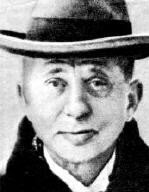Leslie George Stone hanged at Pentonville Prison on this date in 1937 for a murder that was revealed by the fabric of his trousers.
The naked body of Stone’s ex-flame Ruby Keen had turned up in the Bedfordshire town of Leighton Buzzard — strangled with a scarf after what looked a desperate struggle.
Now, Stone would already be a suspect here because of his relationship, and the fact that they’d been seen drinking together in public the preceding night. But what cinched the noose was Scotland Yard taking a variety of cast impressions of the apparent marks left in the earth by the killer.

Casts of the killer’s footprints taken by Scotland Yard from the murder scene of Ruby Keen. From the collection of Scotland Yard’s “Black Museum”.
Sample pairs of trousers were taken from all the possible suspects in the case. When Spilsbury examined Stone’s brand-new suit trousers he found that the knees had been brushed so hard that the nap had been worn away. Microscopic examination of the trousers showed up particles of sandy soil that matched that from the scene of the crime. There was also found, in the lining of Stone’s jacket, a silk fibre that matched with those taken from the dead girl’s underskirt. (Source)
If we’re being honest, “matches” of fiber even now are basically junk forensics that continue to go routinely, maddeningly overclaimed in courtrooms. But the same quality of incriminatory flimflam that enrolls fiber matches in so many wrongful conviction cases seems here to have been spotlighted the right guy. By the time of his trial Stone had to come off his demonstrable falsehoods about his and Keen’s movements on the night of her death, and submitted unpersuasive testimony that he’d strangled her as an accidental exuberance in a fight, and left her still alive.
On this day..
- 1831: Dic Penderyn, Merthyr Rising martyr - 2020
- 1997: Ali Reza Khoshruy Kuran Kordiyeh, the Tehran Vampire - 2018
- Feast Day of Pope Pontian and Antipope Hippolytus - 2017
- 1891: Bir Tikendrajit, Patriots' Day martyr - 2016
- 1575: Charles du Puy-Montbrun, unequal - 2015
- 1864: Barney Gibbons, chance recognition - 2014
- 1997: Chiang Kuo-ching, Taiwan wrongful conviction - 2013
- 1926: Richard Whittemore, Mencken subject - 2012
- 1915: George Joseph Smith, Brides in the Bath murderer - 2011
- 1776: Neptune, as witnessed by John Gabriel Stedman - 2010
- 1868: Thomas Wells, the first private hanging in England - 2009
- Themed Set: At the End of the Rope - 2008
- 1964: Gwynne Owen Evans and Peter Anthony Allen, England's last hangings - 2008

 The tramp timepiece-fixer with twenty-plus years of child molestation prison time in his 66 years of life,
The tramp timepiece-fixer with twenty-plus years of child molestation prison time in his 66 years of life,  A brigadier general of the
A brigadier general of the  Expelled in his youth from tsarist teaching ranks due to his radicalism, Gastev (
Expelled in his youth from tsarist teaching ranks due to his radicalism, Gastev ( A schoolteacher affectionately known as “Master Da”,
A schoolteacher affectionately known as “Master Da”,  The blackshirted turn of his country in the 1920s had driven Vincenzo into emigre exile, pursued by an in absentia prison sentence for “subversive propaganda tending to insurrection and incitement of class hatred.” He went first in Paris and then in 1931 to the USSR.
The blackshirted turn of his country in the 1920s had driven Vincenzo into emigre exile, pursued by an in absentia prison sentence for “subversive propaganda tending to insurrection and incitement of class hatred.” He went first in Paris and then in 1931 to the USSR.
